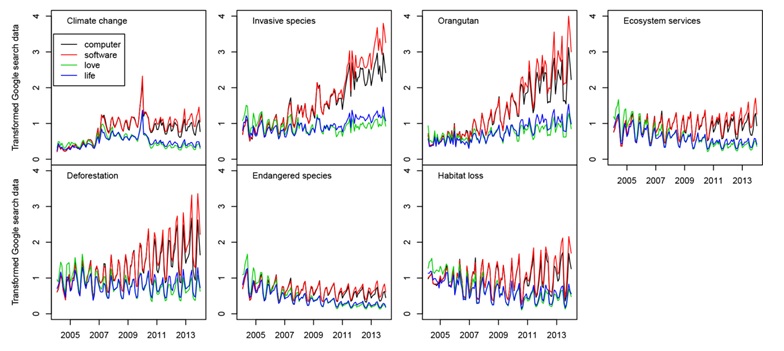The online heartbeat of conservation
Scientists in NUS discovered that Google Trends search patterns show that interest on key conservation topics is not declining over time and that search peaks are driven by online news.
A team led by Ms Le NGHIEM and Prof Roman CARRASCO from the BioEcon Lab of the Department of Biological Sciences in NUS found that over the past 10 years, online interest in conservation topics on Google Trends is not declining for the following topics: climate change, deforestation, orangutan, invasive species and habitat loss. They found that public interest is decreasing for “endangered species” and increasing for “ecosystem services”.
They also found that the quantity of news articles was related to patterns in Google search volume. However, the number of research articles was not a good predictor but lagged behind Google search volume. This highlights the immediate influence of online media coverage of conservation issues on the public, and suggests that researchers are responsive to public interest.
Google Trends has emerged as a source of information to investigate how social trends evolve over time. Knowing how the level of interest in conservation topics varies over time can help support targeted conservation science communication. The evolution of search volume over time and the mechanisms that drive peaks in searches are however, poorly understood. Another added difficulty is that Google Trends data reflect relative instead of absolute popularity, creating a shifting baseline problem due to the addition of new search terms that needs to be corrected.
The team analysed 10 years of Google search patterns data on seven conservation keywords using time series analysis as a function of news and research articles and compared them against different benchmark keywords. This approach allowed them to understand trends while controlling shifting baselines and to explore the factors behind search peaks.
Google Trends data are a powerful tool to monitor and evaluate public interest in conservation. By conducting keyword comparisons within the discipline of conservation, they may gain insight on changing public interest and use this knowledge to prioritise communication about conservation. This is important because the support of the public is fundamental for conservation interventions to work.
Their analysis was done at the global scale using English search terms. Additional analysis for specific regions and other languages would be useful to further understand changes in interest in regional topics. For instance, “invasive species” is a very popular search term in Australia and “deforestation” is a popular search term in Southeast Asia.
Contrary to previous studies, they did not find that overall public interest towards conservation topics is declining. This is due to the fact that they corrected for shifting baselines in the relative popularity of topics over time using multiple benchmark keywords. They also went beyond trend analyses performed by other groups to further understand the peaks observed in search patterns.

Figure shows the transformed Google search data for seven conservation topics analysed from 2004 to 2013 after correcting them using four benchmark keywords “computer”, “software”, “love” and “life”. [Image credit: Nghiem et al. 2016 PLOS One]
Reference
Nghiem LTP, Papworth SK, Lim FKS, Carrasco LR (2016). “Analysis of the Capacity of Google Trends to Measure Interest in Conservation Topics and the Role of Online News”. PLoS ONE 11(3): e0152802. doi: 10.1371/journal.pone.0152802
